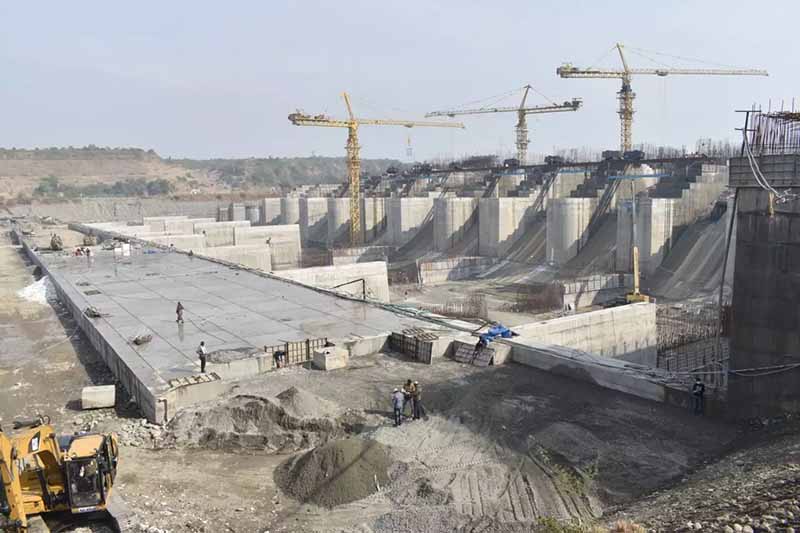The Shahpur Kandi Dam Project, nearing completion, will stop the flow of Ravi Water to Pakistan and supply water for irrigation and power generation. It is an important part of India’s water management and will control the flow of water in Ravi basin.
Much belated, Shahpurkandi Dam project is finally nearing completion, with great hype over India stopping the flow of the Ravi water to Pakistan. A Pakistan newspaper, Dawn, had claimed in 2008 that filling of reservoir for Baglihar dam (on the Chenab river) had resulted in 30% crop losses. An objective analysis is merited.
The Project
Shahpurkandi Dam has been the missing part of Ranjit Sagar Dam project. After an initial agreement in 1979, Shahpurkandi Dam project was announced in 2001.
It was declared a national project in 2008, but work commenced in 2013, only to get stalled in 2014. Centre stepped in during 2018 to resolve bickering between Punjab and J&K. In all, 98% work is complete and filling of the balance reservoir has commenced.
It will take three months to fill up the reservoir for projected power-generation requirements. Balancing reservoir is an essential prerequisite to exercising positive control on water.
Shahpurkandi Dam is multipurpose and includes two hydel projects (55.5m height) with an installed capacity of 206 MW. It will also check uncontrolled flow of water (approximately 2 MAF) to Pakistan.
It is projected to supply 1,150 cusecs of water for irrigating 32,173 hectares in the Kandi belt of Kathua-Samba corridor through Main Ravi Canal.
The earlier, tedious method of lifting water into Tawi Lift Canal will get simplified with gravity feed. Regulated water supply in canals will also bolster defence potential of the vulnerable Kathua-Samba corridor.
J&K will get 20% share of power. Punjab, besides getting 80% power, will draw water to irrigate additional 5,000 hectares. Balancing the reservoir will also optimise water supply to Upper Bari Doab Canal, which was erratic and dictated by power generation considerations.’
Hydrology of the Ravi
Indus Water Treaty allows India to use the water of three western rivers — Ravi, Beas and Satluj. As per estimates, 95% water will be used, but some water, especially in the rauny season, could still flow to Pakistan. The Ravi basin includes many tributaries like Ujh, which come together after transiting through Pakistan.
A follow-up project, at Makaura-Pattan in Gurdaspur, is envisaged to further impound approximately 600 cusecs of water for irrigation and drinking.
Punjab had demanded central funding of Rs 412 crore in 2019. Haryana has even pitched for an ambitious link canal, from the proposed dam to Harike.
Ravi is a trans-border river, defining 70 km of IndoPak border and is notorious for shifting its course. It also provides several enclaves to both sides.
These can be used as launchpads, as they obviate the need to fight complex river-crossing operations. Defences are supplemented with ditch-cum-bundh (DCB). Hydrological control of a river aids operational plans.
Challenges: Water Management
India, with the lowest per-capita freshwater availability, has barely 4% freshwater reserves for 17% of the world’s population. Climate change is curtailing availability.
Even by optimistic projections, India has reserves for only 90 days, compared to many countries boasting of two years of reserves. Clean water is becoming a much sought-after resource, as it is required in large quantities for silicon-chip fabrication.
Aggressive Chinese forays in Tibet, to control the water table of Asia, are ascribed to looming domestic water stress and ambitious plans for chip manufacturing. China enjoys upper riparian leverages on our major rivers like Indus, Satluj and Brahmaputra.
The Dragon has a dubious record of opacity and refusal to share even mandated hydrographic data. It was accused of triggering Pare-chu deluge in Satluj (2000) and Brahmaputra floods (2020). It is building Yarlung-Zangbo dam on Tsangpo (Brahmaputra) with plans to build an 1,100-kmlong channel to Takaltaman desert.
Treaty on Ventilator
Indus Water Treaty mandated 85% share to Pakistan, with near total share of three western rivers — Indus, Jhelum and Chenab.
Notwithstanding this pronounced pro-Pakistan tilt, the treaty allows India to build storage for run-of-river projects for power generation and livelihood issues like navigation and flood storage.
India is allowed storage of 3.6 MAF and has potential to generate 18,653 MW power, whereas our current utilisation is barely 0.75 MAF (31%) storage and 3,264 MW (17%) hydro-power.
Pak obduracy is also resulting in delay in de-silting operations in existing dams, notably Salal (Reasi), on Chenab. The abysmal track record of water management in Pakistan is reflected in debilitating deluge in 2022 and build-up of salinity in the Indus basin.
Belated Indian efforts like the Kishanganga project and Ratle dam on Chenab have been dragged by Pakistan, concurrently to the Court of Arbitration and neutral experts.
India has refused to be a party to such dispute resolution mechanisms. Resultantly, annual meetings of the Indus Water Treaty Commission have become irregular since Uri (2016) and Pulwama (2019) attacks. The last meeting was held in May 2022.
Inevitability of Water Stress
In Jan 2023, India gave a notice for re-negotiation and modification of the treaty. The key requirement is to convince Pakistan to allow India to harness her agreed share on western rivers.
A bigger challenge is to convince China to behave as a responsible upper-riparian state. Gen Pervez Musharraf (retd), in his RCDS thesis, had inferred that water will be the trigger for the next Indo-Pak conflict. For Pakistan, Ravi is the river of Lahore and Punjab.
It is resuscitated in Pakistan, by link canals from Marala Dam on Chenab. A famous ghazal by Pakistan singer Sajjad Ali sums it up: Jeh Ravi vich pani koi na, teh apni kahani koi na (if there is no water in the Ravi, we have no story to tell).”

